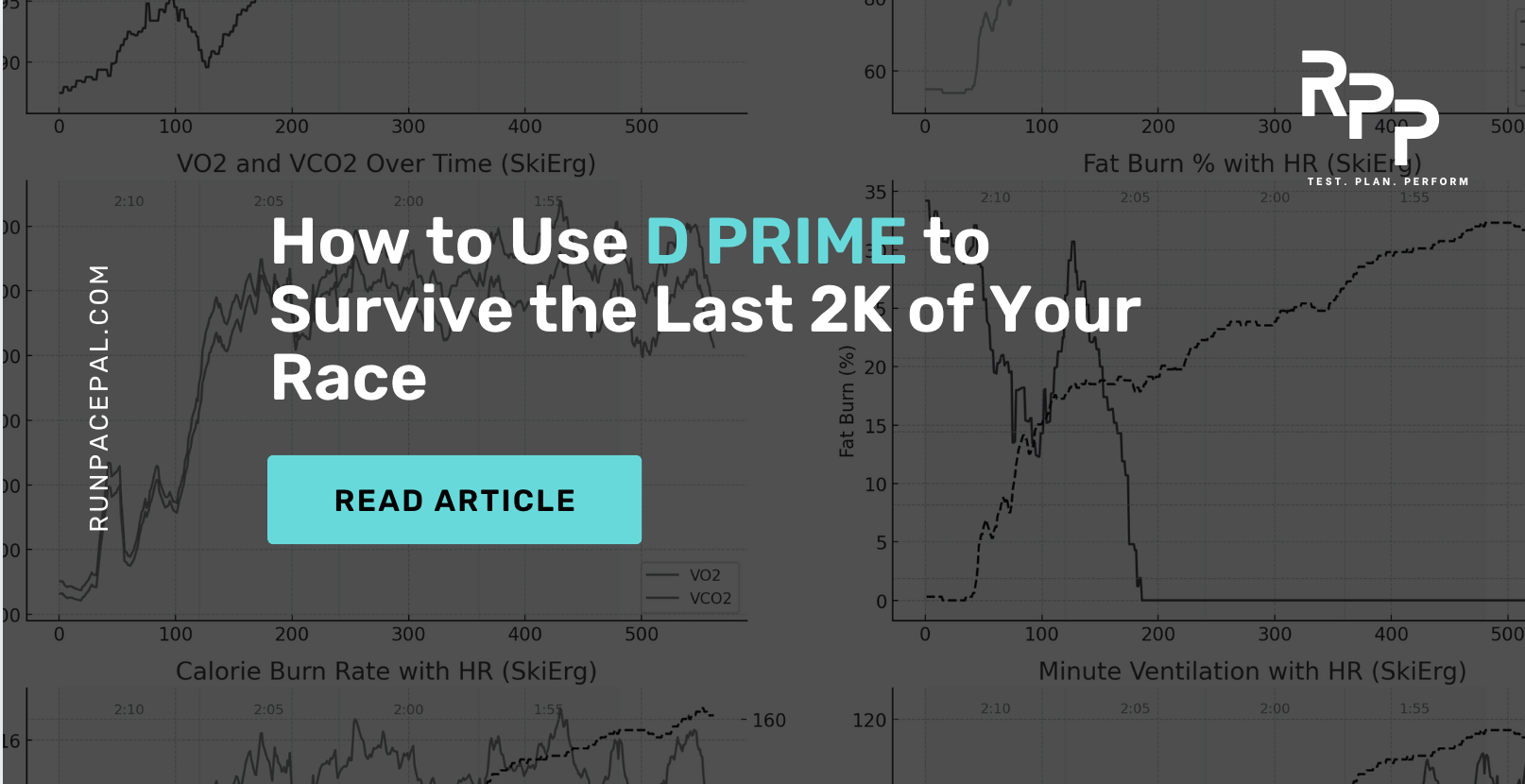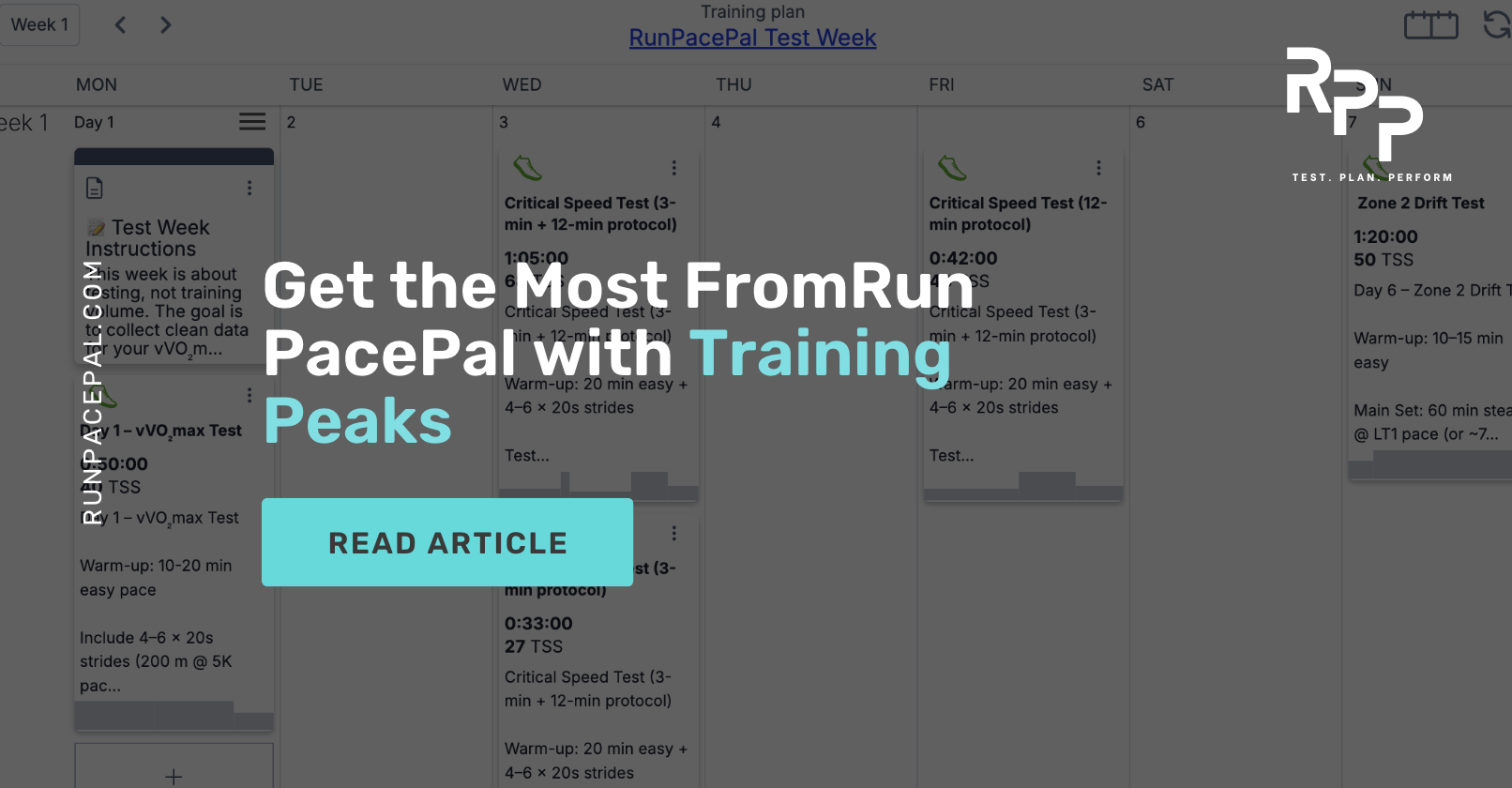How to Use D′ to Survive the Last 2K of Your Race
Every runner knows the feeling. You're 8 km into a 10K or 18 km into a half marathon, and suddenly the final stretch feels like running through wet cement. Legs are heavy, lungs are screaming, heart rate is high, and the finish line feels impossibly far away.
Why does this happen? And more importantly, how can you train and pace to avoid it?
The answer lies in a little-known but powerful concept in endurance science: D′ (D prime) — your anaerobic battery.
What Is D′?
To understand D′, we first need to revisit Critical Speed (CS).
- Critical Speed (CS) is the highest speed you can sustain without rapidly fatiguing. Think of it as your red-line pace.
- D′ (D prime) is the finite amount of work you can do above that red line before exhaustion.
The Car Analogy
- Your aerobic system (CS) is the car's main fuel tank — it lasts a long time
- Your D′ is the nitrous boost — powerful, but limited. Every surge, hill, or pace above CS drains it
Once D′ is gone, there's no negotiating. You slow down, whether you want to or not.
Why D′ Matters in the Final 2K
The final 2K of a race is where D′ decides winners, PBs, and blow-ups.
Spend Too Much Early
If you've burned through D′ in surges, hills, or an over-ambitious first half, there's nothing left for the closing stretch.
Manage It Wisely
Save a portion of D′ to deploy in the final 2K, and you can surge past fading competitors.
Research Evidence: Dupont et al. (2002) showed that intermittent runs above Critical Speed increase time spent near VO₂max but rapidly deplete anaerobic capacity (PubMed 12179954). In plain English: push too hard, too often, and your D′ is gone.
The Math of D′
Here's a simple example:
Runner Profile: - Critical Speed = 4:00/km - D′ = 300m
At 3:40/km (20s faster than CS), they can last ~6 minutes before exhaustion.
Race Application: If they surge at 3:40/km in the last 2K, they'll make it — but only if they've preserved their D′ earlier in the race.
If D′ is already depleted? They'll crash well before the finish line.
Training D′
The good news: like any system, D′ can be trained. Here's how:
1. Intervals Above CS
Protocol: 3–6 × 2–4 min at 105–110% CS, with incomplete recovery
Purpose: Builds tolerance to working above red line
2. Repeated Surges
Protocol: Fartlek runs with bursts above threshold, then recovery just below CS
Purpose: Trains D′ use and recharge
3. Race-Specific Workouts
Protocol: Long runs with the final 15–20% at 105–110% CS
Purpose: Teaches you to deploy D′ at the end, just like in competition
Why This Works: Dupont's research highlights why intervals above CS are so effective — they expand your ability to tolerate repeated bouts near VO₂max.
Pacing With D′
The art isn't just building D′ — it's spending it wisely.
10K Pacing Strategy
- First 8K: Run at CS + 5–10s/km
- Final 2K: Deploy 20–30% of D′ for surge
Half Marathon Strategy
- First 18K: Sit just below CS
- Final 2–3K: Deploy D′ for finishing surge
Marathon Strategy
- First 37K: You'll rarely touch D′
- Final 5K: If you've paced right, D′ is there to hold form or push
Real-World D′ Management
The Smart Racer
Mile 1-3: Runs 5-10 seconds per km slower than Critical Speed
Mile 4-6: Maintains exactly Critical Speed pace
Final 2K: Deploys 60-70% of remaining D′ for strong finish
Result: Negative split, strong finish, personal best
The D′ Squanderer
Mile 1-3: Runs at Critical Speed pace (using D′)
Mile 4-6: Forced above Critical Speed by hills (burning more D′)
Final 2K: D′ depleted, forced to slow dramatically
Result: Positive split, death march finish, missed goals
Advanced D′ Concepts
D′ Recovery
D′ isn't gone forever once depleted. Running below Critical Speed allows partial D′ recovery, but it's slow — typically 2-3 minutes for meaningful restoration.
Environmental Factors
- Heat stress increases D′ depletion rate
- Altitude reduces available D′ capacity
- Headwinds force you above Critical Speed, draining D′
Individual Differences
- Sprinters typically have large D′ reserves (400-600m equivalent)
- Distance specialists have smaller but more efficient D′ (200-400m)
- Middle-distance athletes optimize both CS and D′
How to Calculate Your D′
Field Testing Protocol
- Warm up thoroughly (15-20 minutes)
- 3-minute all-out effort - record distance
- Rest 10 minutes
- 12-minute all-out effort - record distance
- Calculate Critical Speed using the linear relationship
- Calculate D′ from the mathematical model
The Formula
D′ = (Distance₃min - Distance₁₂min × 0.25) / 0.75
This gives you both your Critical Speed and your anaerobic capacity in meters.
Training Periodization for D′
Base Phase (8-12 weeks)
- Focus: Build Critical Speed foundation
- D′ work: Minimal (1 session every 2 weeks)
- Goal: Expand aerobic capacity
Build Phase (6-8 weeks)
- Focus: Develop D′ through specific intervals
- Sessions: 2 D′ sessions per week
- Goal: Increase anaerobic tolerance
Peak Phase (2-4 weeks)
- Focus: Race-specific D′ deployment
- Sessions: 1 D′ session per week, race simulation
- Goal: Perfect D′ pacing strategy
Troubleshooting D′ Problems
"I Always Die in the Last 2K"
Problem: D′ depletion from over-pacing
Solution: Run first 80% of race 5-10s/km slower than target
"I Finish Too Strong"
Problem: Under-utilized D′ capacity
Solution: Gradually increase early pace until you deploy 70-80% of D′
"I Can't Sustain Surges"
Problem: Small D′ capacity
Solution: Focus on intervals at 110-120% Critical Speed
Technology and D′
Modern running technology can help optimize D′ usage:
Power Meters
- Track real-time power above Critical Power
- Calculate D′ depletion during the race
- Provide pacing guidance for optimal D′ conservation
Heart Rate Monitors
- Identify D′ depletion through HR drift patterns
- Monitor recovery during easier sections
- Guide interval training intensity
Nutrition and D′
Pre-Race Strategy
- Carbohydrate loading maximizes D′ capacity
- Caffeine can enhance D′ utilization efficiency
- Proper hydration prevents premature D′ depletion
During Race
- Early fueling preserves D′ for later use
- Electrolyte balance maintains D′ power output
- Strategic timing of fuel intake around D′ deployment
Ready to Master Your D′?
Understanding and training D′ transforms race strategy from guesswork into science. No more death marches. No more wondering "what if."
Our Critical Speed Calculator determines both your Critical Speed and D′ capacity, giving you the exact data needed to:
- Calculate sustainable race paces
- Design D′-specific training sessions
- Plan perfect race execution strategies
Free testing takes 20 minutes. The insights last a lifetime.
Want Laboratory-Grade Validation?
Professional VO₂max and lactate testing provides even deeper insights into your anaerobic capacity and power profile.
👉 Book professional testing: boxnutrition.co.uk/book-online
Key Takeaways
- Critical Speed = your red line pace
- D′ = your anaerobic battery above that line
- The final 2K is where D′ decides whether you surge or crash
- Training D′ with specific intervals builds finishing strength
- Smart pacing preserves D′ for when you need it most
- Technology can help optimize D′ usage and training
Stop guessing. Start training with precision.
Your next personal best is waiting in those final 2K — if you have the D′ to seize it.
Master the science of racing with our free Critical Speed and D′ calculator, or validate your results with professional lab testing for gold-standard precision.



